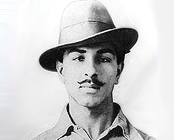Bhagat Singh
by Rameshraj[ Edit ] 2010-02-10 11:52:38
Bhagat Singh

Bhagat Singh, a symbol of heroism, was born in a Sikh family in Layalpur, Punjab on September 27, 1907. He was a national hero who gave a new wave to the revolutionary movement in India. His only goal in life was the destruction of British Empire.
Bhagat started his education in DAV School in Lahore but was not able to complete his studies because he was highly disturbed and influenced by the Jalianwala Bagh massacre at the age of 12. His desire to drive British out from India became stronger and he joined the Non-Cooperation Movement called by Gandhi Ji in 1921. The incidence of Chauri-Chaura in Gorakhpur made Bhagat violent and he decided to earn freedom with armed revolution rather than non-violence. He then joined the National College in Lahore, a center of revolutionary activities.
To spread message of revolution in Punjab, Bhagat formed a union of revolutionaries by the name ‘Naujavan Bharat Sabha’ and gave a call for mass mobilization. In 1928, he went to Delhi to attend a meeting of revolutionaries’ and there he came in contact with Chandrashekhar Azad. With a common aim to establish republic in India they both formed ‘Hindustan Samajvadi Prajatantra Sangha’. There were protests against of Simon Commission visit to India and in this protest Lala Lajpat Rai was brutally lathi charged and later on he died. This added to the anger and discontent of Bhagat and he was determined to kill the British official and Deputy Inspector General Scott responsible for the death of Lala Lajpat Rai. By mistake, he killed assistant superintendent Saunders and ran from Lahore to escape punishment. He threw a bomb in the Central Legislative Assembly on April 18, 1929 and was sentenced to death on March 23, 1931.
Though dead, Bhagat Singh is still living in the history of humanity and remembered as a prominent face of the freedom struggle.
